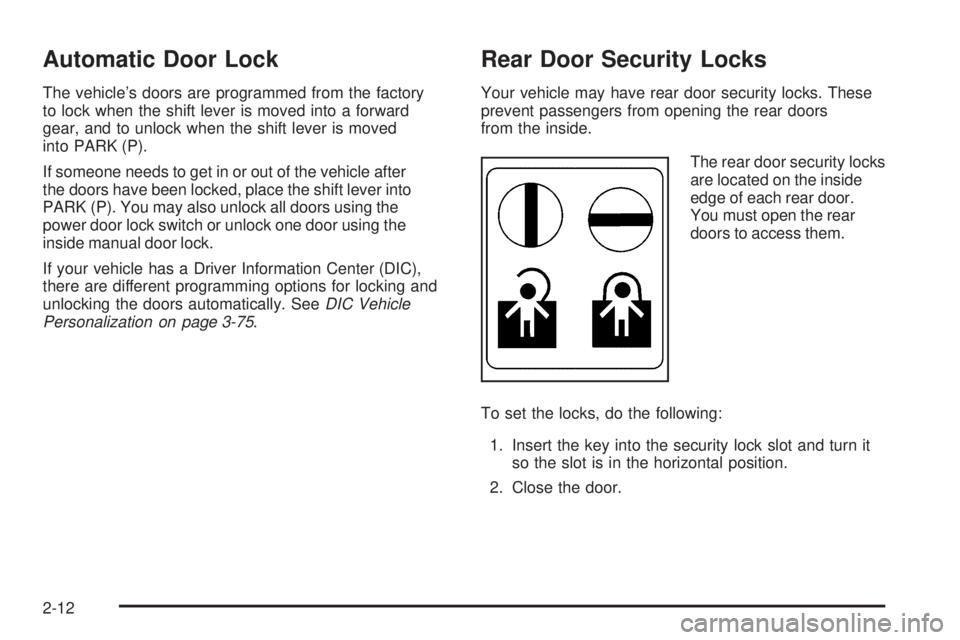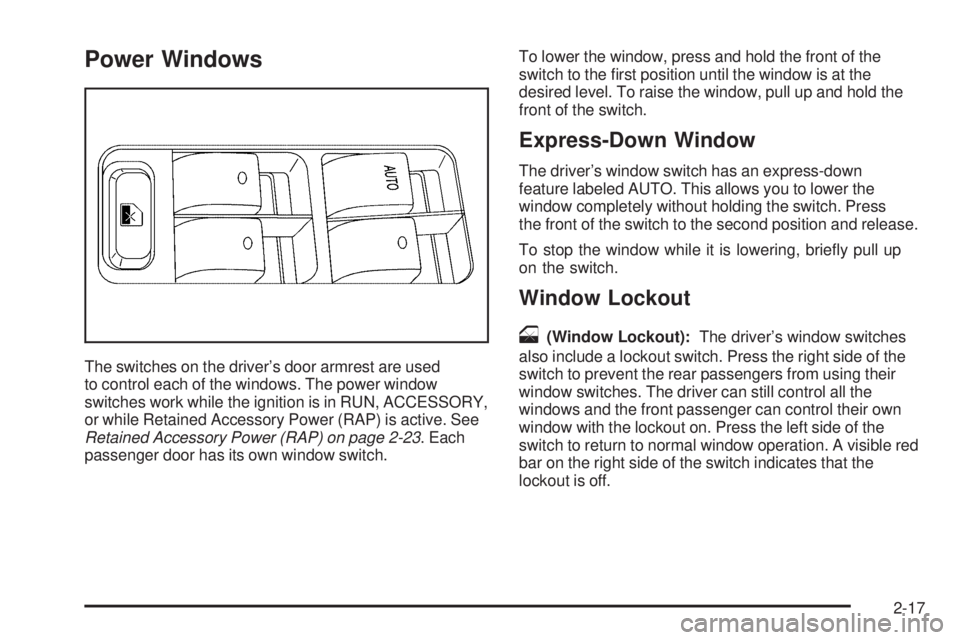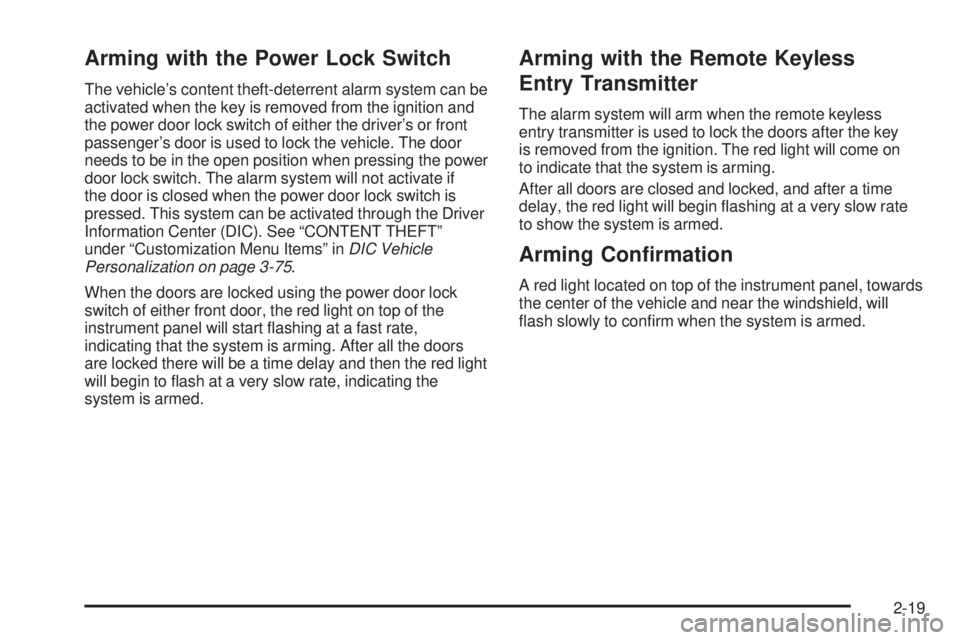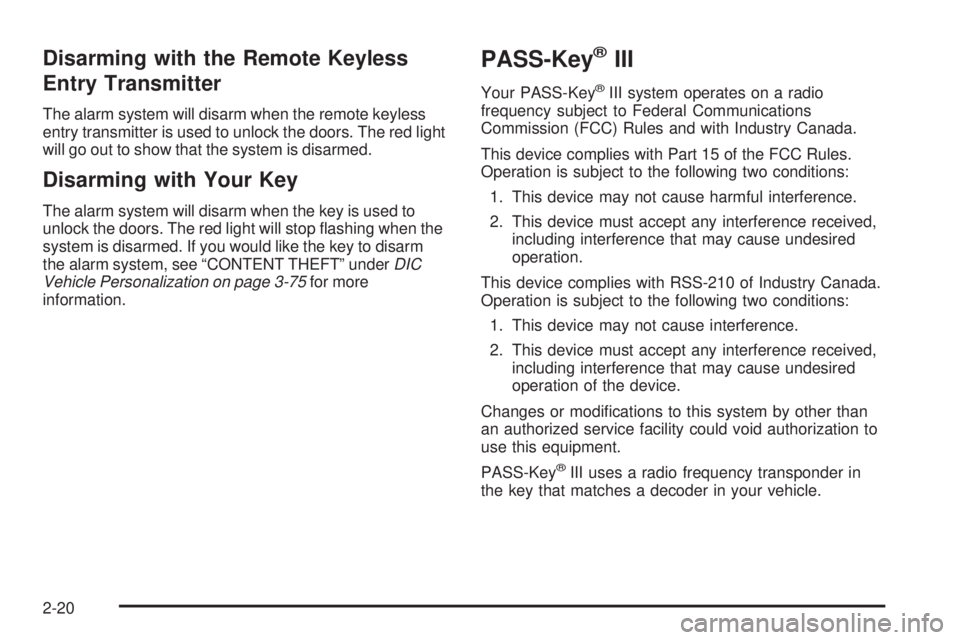2006 BUICK LACROSSE lock
[x] Cancel search: lockPage 90 of 444

Automatic Door Lock
The vehicle’s doors are programmed from the factory
to lock when the shift lever is moved into a forward
gear, and to unlock when the shift lever is moved
into PARK (P).
If someone needs to get in or out of the vehicle after
the doors have been locked, place the shift lever into
PARK (P). You may also unlock all doors using the
power door lock switch or unlock one door using the
inside manual door lock.
If your vehicle has a Driver Information Center (DIC),
there are different programming options for locking and
unlocking the doors automatically. SeeDIC Vehicle
Personalization on page 3-75.
Rear Door Security Locks
Your vehicle may have rear door security locks. These
prevent passengers from opening the rear doors
from the inside.
The rear door security locks
are located on the inside
edge of each rear door.
You must open the rear
doors to access them.
To set the locks, do the following:
1. Insert the key into the security lock slot and turn it
so the slot is in the horizontal position.
2. Close the door.
2-12
Page 91 of 444

When you want to open a rear door when the security
lock is on, do the following:
1. Unlock the door using the remote keyless entry
transmitter, if equipped, the power door lock
switch, or by lifting the rear door manual lock.
2. Open the door from the outside.
To cancel the rear door security lock, do the following:
1. Unlock the door and open it from the outside.
2. Insert the key into the security lock slot and turn
it so the slot is in the vertical position.
Lockout Protection
The lockout protection feature makes it more difficult
to lock the key in the vehicle. If the driver’s door is open
while the key is in the ignition, the door cannot be locked
with the power door lock switch.
This feature cannot guarantee that you will never be
locked out of the vehicle. If the key is not left in the
ignition, or, if the manual door lock is used, the key
could still be locked inside the vehicle. Always
remember to take the key with you.
Trunk
{CAUTION:
It can be dangerous to drive with the trunk lid
open because carbon monoxide (CO) gas can
come into your vehicle. You cannot see or
smell CO. It can cause unconsciousness and
even death. If you must drive with the trunk lid
open or if electrical wiring or other cable
connections must pass through the seal
between the body and the trunk lid:
Make sure all other windows are shut.
Turn the fan on your heating or cooling
system to its highest speed and select the
control setting that will force outside air
into your vehicle. See Climate Control
System.
If you have air outlets on or under the
instrument panel, open them all the way.
SeeEngine Exhaust on page 2-34.
2-13
Page 92 of 444

Opening the Trunk
To open the trunk from the outside, use the remote
keyless entry transmitter. SeeRemote Keyless Entry
System Operation on page 2-4for more information.
The ignition must be off, or the transaxle must be
in PARK (P), to open the trunk.
If the vehicle has lost power, you can open the trunk
by lowering the split folding rear seat, if equipped, and
pulling the emergency trunk release handle located in
the trunk. SeeSplit Folding Rear Seat on page 1-8and
“Emergency Trunk Release Handle” following.
Remote Trunk Release
This feature is used to unlock the trunk from inside
the vehicle using the power door lock switch.
Press and hold the top
of the driver’s or front
passenger’s power door
lock switch for one and
one-half seconds to
unlock the trunk.
The vehicle must be in PARK (P) to unlock the trunk.
2-14
Page 95 of 444

Power Windows
The switches on the driver’s door armrest are used
to control each of the windows. The power window
switches work while the ignition is in RUN, ACCESSORY,
or while Retained Accessory Power (RAP) is active. See
Retained Accessory Power (RAP) on page 2-23. Each
passenger door has its own window switch.To lower the window, press and hold the front of the
switch to the �rst position until the window is at the
desired level. To raise the window, pull up and hold the
front of the switch.
Express-Down Window
The driver’s window switch has an express-down
feature labeled AUTO. This allows you to lower the
window completely without holding the switch. Press
the front of the switch to the second position and release.
To stop the window while it is lowering, brie�y pull up
on the switch.
Window Lockout
o
(Window Lockout):The driver’s window switches
also include a lockout switch. Press the right side of the
switch to prevent the rear passengers from using their
window switches. The driver can still control all the
windows and the front passenger can control their own
window with the lockout on. Press the left side of the
switch to return to normal window operation. A visible red
bar on the right side of the switch indicates that the
lockout is off.
2-17
Page 96 of 444

Sun Visors
To block out glare, swing down the sun visors. They can
be detached from the center retainer and slid along the
rod to cover different areas of the front window and
rotated to cover the side windows.
Visor Vanity Mirror
Swing down the sun visors and lift the cover to expose
the vanity mirror. Do not drive with the cover lifted due to
possible glare impeding other drivers behind or to the
side of the vehicle.
Theft-Deterrent Systems
Vehicle theft is big business, especially in some cities.
Although your vehicle has a number of theft-deterrent
features, we know that nothing we put on it can make it
impossible to steal.
Content Theft-Deterrent
Your vehicle may have a content theft-deterrent
alarm system.
A red light located on top
of the instrument panel,
toward the center of the
vehicle and near the
windshield, will �ash
slowly when the system
is armed.
The theft-deterrent alarm system needs to be activated
through the Driver Information Center (DIC). See
“CONTENT THEFT” under “Customization Menu Items”
inDIC Vehicle Personalization on page 3-75. While
armed, the doors will not unlock with the power door lock
switch. The remote alarm will sound if someone tampers
with the trunk or enters the vehicle without using the
remote keyless entry transmitter or key to unlock the
doors. The horn will sound and the headlamps will �ash
for up to two minutes. The system will also cut off the fuel
supply, preventing the vehicle from being driven.
2-18
Page 97 of 444

Arming with the Power Lock Switch
The vehicle’s content theft-deterrent alarm system can be
activated when the key is removed from the ignition and
the power door lock switch of either the driver’s or front
passenger’s door is used to lock the vehicle. The door
needs to be in the open position when pressing the power
door lock switch. The alarm system will not activate if
the door is closed when the power door lock switch is
pressed. This system can be activated through the Driver
Information Center (DIC). See “CONTENT THEFT”
under “Customization Menu Items” inDIC Vehicle
Personalization on page 3-75.
When the doors are locked using the power door lock
switch of either front door, the red light on top of the
instrument panel will start �ashing at a fast rate,
indicating that the system is arming. After all the doors
are locked there will be a time delay and then the red light
will begin to �ash at a very slow rate, indicating the
system is armed.
Arming with the Remote Keyless
Entry Transmitter
The alarm system will arm when the remote keyless
entry transmitter is used to lock the doors after the key
is removed from the ignition. The red light will come on
to indicate that the system is arming.
After all doors are closed and locked, and after a time
delay, the red light will begin �ashing at a very slow rate
to show the system is armed.
Arming Con�rmation
A red light located on top of the instrument panel, towards
the center of the vehicle and near the windshield, will
�ash slowly to con�rm when the system is armed.
2-19
Page 98 of 444

Disarming with the Remote Keyless
Entry Transmitter
The alarm system will disarm when the remote keyless
entry transmitter is used to unlock the doors. The red light
will go out to show that the system is disarmed.
Disarming with Your Key
The alarm system will disarm when the key is used to
unlock the doors. The red light will stop �ashing when the
system is disarmed. If you would like the key to disarm
the alarm system, see “CONTENT THEFT” underDIC
Vehicle Personalization on page 3-75for more
information.
PASS-Key®III
Your PASS-Key®III system operates on a radio
frequency subject to Federal Communications
Commission (FCC) Rules and with Industry Canada.
This device complies with Part 15 of the FCC Rules.
Operation is subject to the following two conditions:
1. This device may not cause harmful interference.
2. This device must accept any interference received,
including interference that may cause undesired
operation.
This device complies with RSS-210 of Industry Canada.
Operation is subject to the following two conditions:
1. This device may not cause interference.
2. This device must accept any interference received,
including interference that may cause undesired
operation of the device.
Changes or modi�cations to this system by other than
an authorized service facility could void authorization to
use this equipment.
PASS-Key
®III uses a radio frequency transponder in
the key that matches a decoder in your vehicle.
2-20
Page 99 of 444

PASS-Key®III Operation
Your vehicle is equipped
with PASS-Key®III
(Personalized Automotive
Security System)
theft-deterrent system.
PASS-Key
®III is a passive
theft-deterrent system.
This means nothing special
needs to be done to arm
or disarm the system.
It works when the key is
inserted or removed
from the ignition.
PASS-Key
®III uses a transponder in the ignition key
that matches a decoder in the vehicle.
When the PASS-Key
®III system senses that the wrong
key has been inserted into the ignition, it shuts down the
vehicle’s starter and fuel systems. The starter will not
work and fuel will stop �owing to the engine. If someone
tries to start the vehicle again with the wrong key, the
vehicle will not start. Anyone using a trial-and-error
method to start the vehicle will be discouraged to do so
because of the high number of electrical key codes.When trying to start the vehicle, if the engine does not
start and the STARTING DISABLED warning message
on the Driver Information Center (DIC) comes on, the key
may have a damaged transponder. Turn the ignition off
and try again.
If the engine still does not start, and the key appears to
be undamaged, try another ignition key. At this time, you
may also want to check the fuse. SeeFuses and Circuit
Breakers on page 5-93. If the engine still does not start
with the other key, the vehicle needs service. If the
vehicle does start, the �rst key may be faulty. See your
dealer who can service the PASS-Key
®III to have a
new key made. In an emergency, contact Roadside
Assistance. SeeRoadside Assistance Program on
page 7-6for more information.
It is possible for the PASS-Key
®III decoder to accept
the transponder value of a new or replacement key.
Up to 10 keys may be programmed for the vehicle.
The following procedure is for programming additional
keys only. If all the programmed keys are lost or do
not operate, see your dealer or a locksmith who
can service PASS-Key
®III to have keys made and
programmed to the system.
2-21